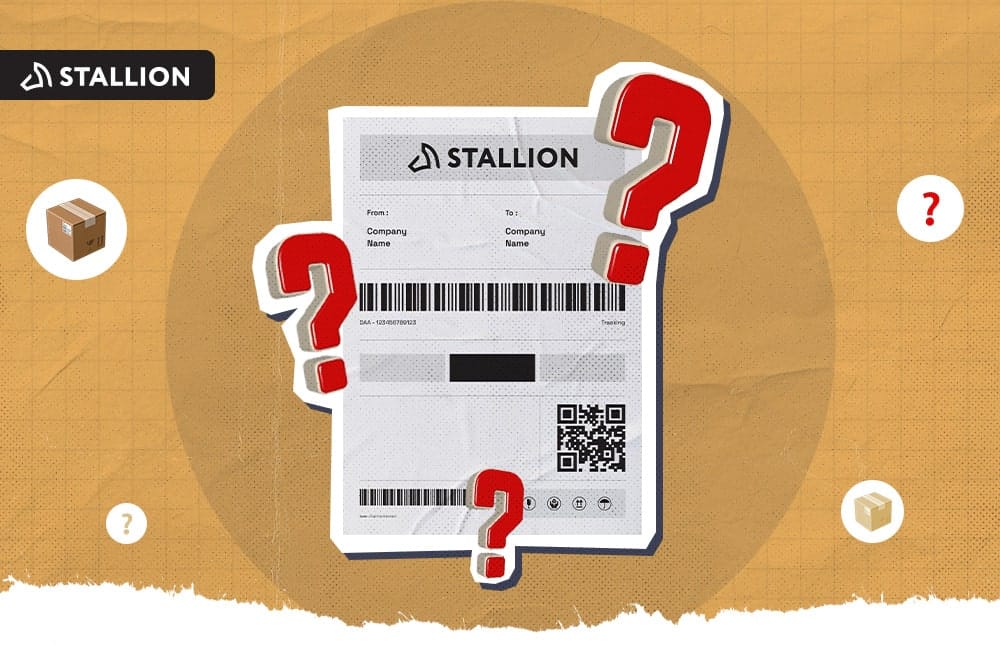
While having serious shipping issues, such as missing, damaged, or stolen packages, does not happen often, they should not be overlooked. Shipping insurance is vital in ensuring that your items are well-protected and from any form of shipping problem, physically and financially.
But what is it? How much does it cost? How can shippers use it? This article will answer these questions. Plus, you will find a cost-effective alternative for a more practical and efficient way of shipping packages nationwide, to the United States, and internationally.
Shipping insurance operates on the principle of reimbursing the sender for the declared value of items within a package. Still, this compensation is contingent upon the package being insured and subsequently suffering loss, theft, or damage.
In certain instances, insurance coverage is included in the service fee. For example, major shipping carriers like FedEx and UPS provide declared value liability coverage of up to $100 for each parcel shipped.

Shipping insurance typically covers a range of common issues and risks associated with goods transportation. Shippers should carefully review the terms and conditions of their insurance policies to ensure they understand what is covered and what may be excluded. Coverage limits and deductibles may also apply, so selecting insurance aligning with the value and nature of the items being shipped is essential.
Due to the extensive and intricate logistical networks involved in moving products, loss or theft is a common problem in shipping. The sheer shipping volume, coupled with numerous touchpoints in the supply chain, increases the likelihood of errors, security breaches, and lost packages.
Delivery routes, warehouses, and transportation hubs are susceptible to theft from dishonest people or organized criminal operations. Factors like inadequate tracking systems, human error, and natural disasters also contribute to lost packages. The global nature of shipping and varying regulatory environments also present challenges.
Breakage due to mishandling is a common issue because of the logistics process's intricate and often high-speed nature.
Parcels and packages may go through multiple handoffs and various modes of transportation, increasing the risk of rough handling or accidental impacts. The issue can worsen due to inadequate packaging, insufficient protective measures, or improper labelling. Moreover, time-sensitive deliveries and heavy workloads for handlers can lead to rushed or careless actions.
In a highly dynamic and complicated shipping environment, this problem highlights the value of strong packaging methods, cautious handling procedures, and shipping insurance to minimize financial consequences and guarantee safe item delivery.
These are common issues primarily due to the unpredictability of environmental forces. Ships and cargo are exposed to a wide range of natural hazards, including storms, hurricanes, earthquakes, and wildfires. These events can result in ship damage, cargo losses, or even complete shipwrecks. Fires can also start in warehouses, storage facilities, and transportation hubs due to electrical faults, accidents, or arson.
The likelihood of witnessing such situations rises due to the worldwide nature of shipping exposure to diverse climates and geographies, increasing the likelihood of encountering such events.
Complex global supply chains, varying customs procedures, inclement weather, and shipping volume can disrupt timely item movements, which can be worsened due to traffic congestion, particularly in urban areas and during rush hours.
Schedules can also be affected by equipment malfunctions, labour strikes, and logistical errors. Due to the industry's interconnectedness, a single delay can have a domino impact on the entire supply chain.
Misdeliveries are common issues because of the complexity of handling numerous packages with diverse destinations. It can occur due to human error, such as inaccurate address entry or parcel sorting errors, as mix-ups are more likely during peak seasons with high package volumes.
In some instances, errors in delivery can also happen due to poor communication between shippers and carriers. Furthermore, unclear or poorly designated addresses can confuse the delivery crew, especially in numerous urban locations sharing street names or numbering schemes.
Hidden damages are common because some package issues are not immediately visible upon delivery. Shippers may receive seemingly intact packages only to discover concealed damage upon opening them. This occurs due to the rough handling, stacking, or internal shifting of items during transit. Unfortunately, hidden damages can be challenging to find and report immediately, making the claims process more difficult.
The responsibility for shipping insurance primarily lies with the shipper (sender) or the party with a vested interest in protecting the imported goods.
Shippers typically purchase and arrange shipping insurance to safeguard the declared value of the items during transit. However, clarifying insurance responsibility in shipping agreements, contracts, or sale terms is crucial. In some cases, recipients may purchase additional insurance to protect their interests.
Although shipping carriers may provide limited liability coverage, this sometimes falls short of complete protection, especially for shipments valued at expensive or fragile items. Ultimately, responsibility for shipping insurance is a matter of negotiation and agreement among the third-party vendors (typically the senders) and buyers (typically the recipients).
Whether it's worth getting shipping insurance coverage vary on several factors, including the item value and nature being sent, the shipping method, and the potential risk involved.
Here are some considerations to help you decide:
Check the liability limits of the carrier. If it is insufficient to cover the full value of your shipment, it can be a wise decision to purchase supplementary insurance.
Insurance provides peace of mind by acting as a financial safety net in unpredictable situations. This assurance ensures you have a protective cushion to help recover potential losses, fostering confidence and security in your shipping endeavours.
Consider the expense of insurance in relation to your shipment's worth. Sometimes, shipping insurance premiums can be cheaper than the possible financial consequences of damaged or lost packages. This cost-benefit analysis can underscore the practicality of securing shipping insurance for valuable or sensitive shipments.
Offering shipping insurance options to customers can set you apart from competitors and build trust. It demonstrates a commitment to customer satisfaction, providing added value and assurance, which can be a significant advantage in today's competitive marketplace.
Understanding the insurance provider's claims procedures and any applicable deductibles is crucial. It is essential to ensure that the claims process meets your and your customer's preferences and expectations. This proactive strategy can speed up the handling of prospective problems and offer clarification in the case of a claim.

The cost of shipping insurance in Canada varies widely depending on several factors, such as the value and nature of the items sent, the shipping method, the destination, the chosen shipping insurance provider, and additional coverage options.
Generally, shipping insurance can range from a few dollars for basic coverage to a percentage of the declared value of the items. On average, for domestic shipments within Canada, you might expect to pay* around $1 to $3 for every $100 of insured value.
However, for international shipping, the cost can be higher. It's essential to request estimates from insurance providers to determine precise charges for your specific shipments.
You can purchase shipping insurance through various methods:
A. Carrier Provided Insurance. When using major carriers like FedEx, UPS, or Canada Post, you can typically include shipping insurance as an option during the online shipping process on their websites or at their physical service locations. These carriers offer straightforward methods for adding insurance to your shipments to protect your goods in transit.
B. Third-Party Insurance. Numerous specialized companies offer shipping insurance, and you can directly purchase insurance coverage from them. This can usually be done online through their website or by contacting their customer service representatives. These providers often offer a range of insurance options tailored to your specific shipping needs.
C. Insurance Brokers. For complex shipping requirements, insurance brokers can be invaluable. They can analyze your unique needs, evaluate various options from different providers and major carriers, and help you secure additional coverage aligning precisely with your specific shipping circumstances, providing tailored protection for your shipments.
D. Online Marketplaces. Certain e-commerce platforms provide the convenience of adding insurance options while generating shipping labels. This feature simplifies the process for online sellers, allowing them to protect their shipments seamlessly as they create labels for their orders, often offering coverage based on the shipment's declared value.
Many major shipping carriers offer shipping insurance for parcel delivery. Some of the well-known carriers providing insurance options for delivery include:
Absolutely! There are insurance providers specializing in shipping insurance. These companies offer alternatives to carrier-provided insurance, often providing more flexibility in coverage options and competitive rates. Shippers can purchase shipment protection directly from these providers to protect their shipments during transit.

Stallion, a trusted name in the industry, provides comprehensive package protection to Canadian online sellers at exceptionally competitive rates. With their complete coverage protection, sellers can gain peace of mind knowing that their shipments are safeguarded against various potential risks throughout the shipping journey.
This includes protection against loss, damage, theft, and more. Offering the lowest prices in the industry, Stallion empowers every online business with a cost-effective solution that ensures their valuable goods are covered, reinforcing confidence in every shipment, no matter the destination or circumstances.
You can follow these simple steps to file a claim:
Protecting shipments from loss, damage, and theft while in transit is possible through shipping insurance. Provide yourself with peace of mind, particularly for expensive or delicate objects, and minimize financial risk in the shipping process.
Aman looks after the content marketing department at Stallion Express. He is passionate about helping businesses grow by providing informative and up-to-date trends in the eCommerce industry. Outside the office, you can find him on the soccer field cheering on Real Madrid.



Can our fellow Torontonians relate?
-
#smallbusiness #business #entrepreneur #socialmedia #shipping #ecommerce #canadianecommerce #shopify #poshmark #b2b #saas #etsy #ebay #canada #canadiansmallbusiness #shoplocalcanada #entrepreneur
#toronto

Here’s your quick hassle free shipping from 🇨🇦 to 🇺🇸 as a business owner!
-
Any questions?! Leave them 👇🏻 and save this video so you don’t forget!
-
#smallbusiness #business #entrepreneur #socialmedia #shipping #ecommerce #canadianecommerce #shopify #poshmark #b2b #saas #etsy #ebay #canada #canadiansmallbusiness #shoplocalcanada #entrepreneur

Meet @drinkbenny a 🇨🇦 female founded energy drink brand! Instead of focusing on their products, they’re taking a unique approach by hosting in person events in different Canadian cities to offer an experience for their community 🧡
-
What are your thoughts on in person events? 💭
-
#smallbusiness #business #entrepreneur #socialmedia #shipping #ecommerce #canadianecommerce #shopify #poshmark #b2b #saas #etsy #ebay #canada #canadiansmallbusiness #shoplocalcanada #entrepreneur

Do you know the difference between DDU and DDP when shipping internationally 🌏 ?
-
Questions? Leave them below! 👇🏻
-
#smallbusiness #business #entrepreneur #socialmedia #shipping #ecommerce #canadianecommerce #shopify #poshmark #b2b #saas #etsy #ebay #canada #canadiansmallbusiness #shoplocalcanada #entrepreneur

Here’s a quick hack to save time from choosing multiple postage options
↪️ Turn on the lowest postage rate automation to save you time!
-
Questions? Leave them below! 👇🏻
-
#smallbusiness #business #entrepreneur #socialmedia #shipping #ecommerce #canadianecommerce #shopify #poshmark #b2b #saas #etsy #ebay #canada #canadiansmallbusiness #shoplocalcanada #entrepreneur
